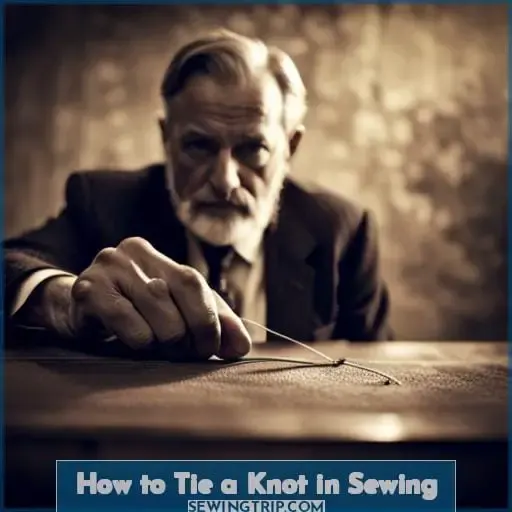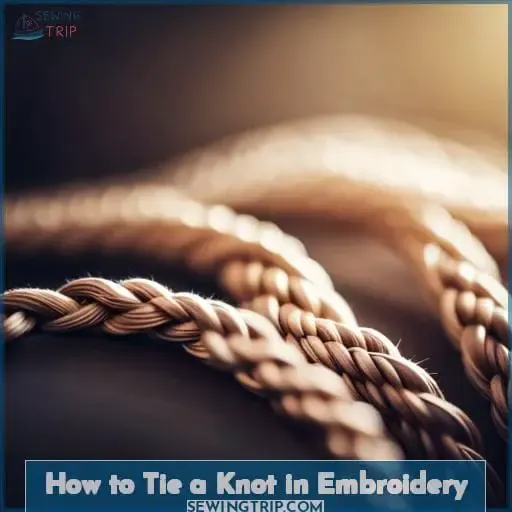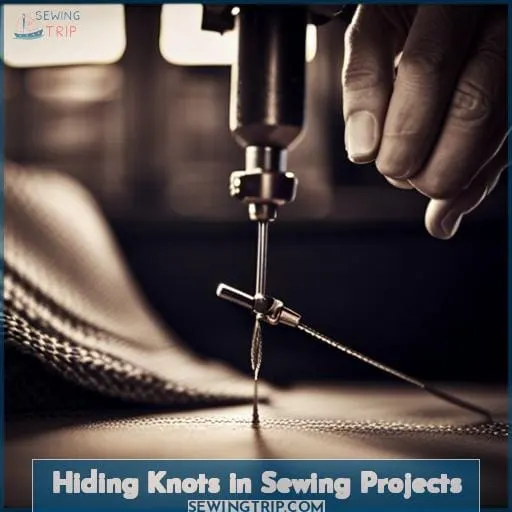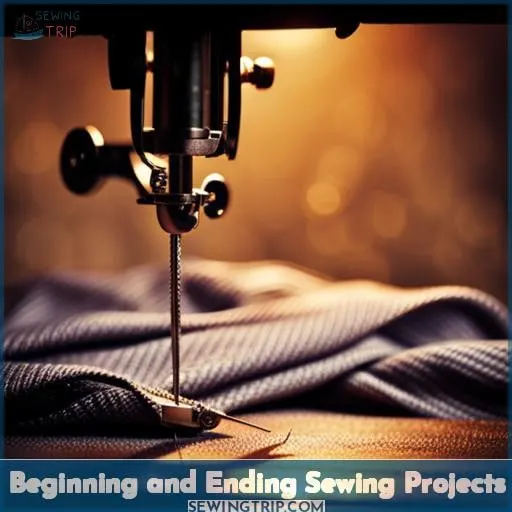This site is supported by our readers. We may earn a commission, at no cost to you, if you purchase through links.
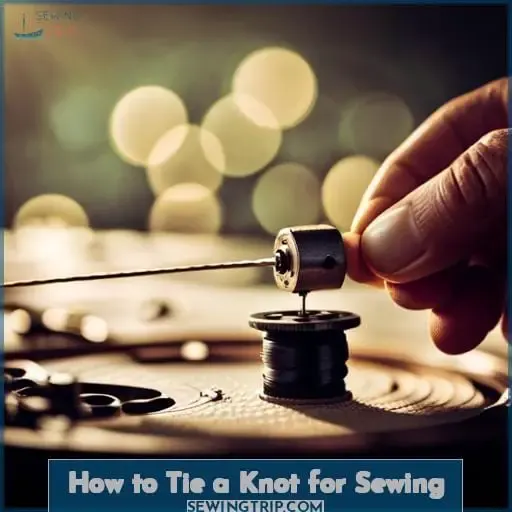 Imagine effortlessly tying a knot that ensures the durability of your sewing projects. In this article, we’ll show you how to tie a knot for sewing like a pro. Whether it’s finishing off seams or securing buttons, these tried-and-true techniques will give you the power and mastery over your needle and thread.
Imagine effortlessly tying a knot that ensures the durability of your sewing projects. In this article, we’ll show you how to tie a knot for sewing like a pro. Whether it’s finishing off seams or securing buttons, these tried-and-true techniques will give you the power and mastery over your needle and thread.
Get ready to unleash your creativity with confidence as we guide you through various knotting methods that will elevate your sewing game.
Table Of Contents
Key Takeaways
- Different knot-tying techniques are utilized in sewing and embroidery projects, including knots made by hand, bullion knot twirls, locking stitch, loop knot stitch, double backstitch, French knot tips, knot variations, securing loose ends, knotless techniques, and utilizing sewing machines.
- Knots can be hidden in sewing projects through techniques such as quilting techniques, thread security in quilting, knot concealment in quilting, seam finishing techniques, and seam knot types.
- Beginning and ending sewing projects require a firm knot and secure ending techniques, including backstitching and specialized knot alternatives.
- Common questions and concerns regarding knot-tying in sewing include matching knot techniques to projects, alternative knot-tying methods, hiding knots for a clean finish, the best knot-tying technique for machine stitching, and tips for starting and ending sewing projects.
How to Tie a Knot in Sewing
Now, let’s delve into the different techniques for tying knots in sewing.
As a skilled seamstress or tailor, you have various options at your disposal to secure your thread effectively. Whether it’s making knots by hand, using bullion knot twirls or locking stitches, employing loop knot stitching methods or double back stitches – each method offers its own advantages and can be utilized depending on the specific requirements of your sewing project.
Let’s explore these techniques further to enhance your sewing skills and ensure sturdy and reliable knots in every stitch.
Knots Made by Hand
To tie a knot in sewing, start by creating 2-3 loops around your right hand forefinger.
- Loop the thread
- Cross over
- Thread through
- Pull tight
Bullion Knot Twirls
Create bullion knot twirls by wrapping the thread over the needle multiple times and slowly easing them down to secure the knot.
Explore various bullion knot variations for decorative applications and unleash your creative threadwork.
Troubleshoot any issues with hiding knots or try out alternative knotless sewing techniques.
Locking Stitch
Secure your thread in hand stitching with the locking stitch. It offers benefits over traditional knots, such as durability and neatness. Variations include the single-threaded needle technique and the double back stitch method.
Mastering the locking stitch will give you a sense of liberation and power in your sewing endeavors. With its numerous variations and applications, you can confidently tackle any project knowing that your threads are securely locked in place.
- Practice proper tension control
- Choose appropriate thread thickness
- Always test on scrap fabric before starting on your main piece.
Loop Knot Stitch
First, securely anchor your thread with the loop knot stitch. Its benefits include strong hold and easy undoing.
Variations exist, along with alternative techniques like tying off on felt or using an embroidery hoop.
Pros and cons depend on the specific application of this versatile technique in sewing projects – whether it’s hand stitching or machine stitching knots using a single threaded needle.
Double Back Stitch
To tie a knot using the double back stitch technique in sewing, start by stitching two backstitches on top of each other for a neat and secure beginning.
Knot variations can be achieved through different thread tensions or adding more stitches.
Incorporating these double back stitches into your sewing projects will ensure your threads are securely fastened without the need for traditional knots, giving you greater control over your work and allowing you to focus on mastering new techniques with ease.
With this knowledge in hand, you now have an understanding of how to tie a knot using the double back stitch technique in sewing. By utilizing this method instead of traditional knots, not only do you create a neater appearance but also gain confidence knowing that your threads are securely anchored without bulky knots getting in the way.
Experiment with different tension levels or additional stitches to explore various knot variations depending on what suits best for each project.
How to Tie a Knot in Embroidery
To tie a knot in embroidery, start by bringing the needle and thread from the back to the front of your fabric.
Once you have done that, it’s time to get creative with your knots! Here are some French Knot tips for adding beautiful embellishments to your embroidery:
- Experiment with different knot variations:
- Try making larger or smaller knots by adjusting how many times you wrap the thread around the needle.
- Secure threads properly:
- To prevent unraveling, make sure to secure any loose ends of thread on the backside of your fabric.
- Explore knotless techniques:
- Instead of tying traditional knots, consider using looped stitches or weaving techniques for a unique look.
- Utilize sewing machines for faster results:
- Some modern sewing machines can automatically tie knots at both ends when stitching.
With these tips in mind, let your imagination run wild as you experiment with various ways to incorporate stunning knotted embellishments into your next embroidery project.
Hiding Knots in Sewing Projects
Now let’s talk about how to hide knots in your sewing projects, specifically when it comes to quilting and seams.
When working on quilts, it’s important to conceal the knot between layers of fabric and batting for a seamless finish.
For professional-looking seam finishes, remember to place the knot on the underside of the seam so that only a neat and knot-free surface is visible.
Quilting
When quilting, ensure a seamless finish by concealing knots between fabric layers and batting.
Use various techniques like French knots or the hemming stitch for thread security and knot concealment.
You can also use a double-threaded needle to start strong without visible knots.
Sewing machines can’t tie knots, so mastering these quilt-specific methods is essential.
| Quilting Techniques | Thread Security | Knot Concealment |
|---|---|---|
| French Knots | Hemming Stitch | Double Threaded Needle |
By incorporating these quilting techniques into your projects, you’ll achieve professional-looking results while maintaining thread security and hiding unsightly knots.
With practice comes mastery in the art of quilting – empowering you to create beautiful pieces that showcase your skills without any visible imperfections.
Seams
To ensure a professional and polished finish to your sewing projects, hide the knots within the seams.
Seam finishing techniques play a crucial role in ensuring seam security.
There are various seam knot types you can use, such as finger knots or even tying without a knot.
Mastering these techniques will give you greater control over your sewing projects.
Embroidery
For a clean and professional finish in your embroidery projects, ensure that you hide the knot underneath the embroidered design using a double preposition.
Consider these options for securing your threads:
- Use decorative knots for added flair
- Explore different embroidery techniques to enhance your designs
- Try knotless finishes for a seamless look
Beginning and Ending Sewing Projects
When beginning a sewing project, it’s crucial to start with a firm knot. This ensures that your thread remains secure and doesn’t loosen or pull out during the stitching process.
Similarly, when finishing your project, ending with a well-tied knot is equally important in preventing unraveling or loosening of the stitches.
Starting and ending on a strong note sets the foundation for a satisfying and professionally finished sewing endeavor.
Importance of a Firm Knot
As you continue sewing, it’s important to emphasize the significance of starting and ending your projects with a firm knot.
The right knot ensures that the thread remains secure throughout the entire process.
There are various types of knots and tying techniques you can use to achieve this level of security.
A strong knot guarantees that your work stays intact, preventing any unraveling or loose ends.
While there may be alternatives for securing threads in sewing projects, nothing quite matches the reliability and stability offered by a well-tied knot.
Ensuring Secure Finishing
- When finishing a sewing project, it’s crucial to ensure a secure ending by tying off the thread with a firm knot.
Thread security is essential to prevent unraveling and maintain the integrity of your work. There are various finishing techniques you can employ to achieve this, such as backstitching or using specialized knot alternatives like the tailor’s knot or surgeon’s knot.
By mastering these sewing knots and ending securely, you’ll have full control over your creations, empowering yourself in the world of fashion design and tailoring.
Frequently Asked Questions (FAQs)
Can I use the same knot-tying technique for all types of sewing projects?
To achieve mastery in sewing, it’s crucial to match the right knot-tying technique with each project.
Different sewing projects require specific knots for secure and professional finishes.
Tailor your knot selection accordingly for optimal results.
Are there any alternative methods to tying knots in sewing?
When it comes to tying knots in sewing, you have alternative methods at your disposal.
Explore the finger-knot technique for quick knotting.
Try the locking stitch method for added security.
Empower yourself with these versatile techniques!
How do I hide knots in my sewing projects to maintain a clean finish?
Achieve a clean finish in your sewing projects by hiding knots.
Conceal them between fabric layers for quilting, underneath embroidery designs, or on the underside of seams.
Take control and master the art of invisible knotting.
What is the best knot-tying technique for machine stitching?
For machine stitching, the best knot-tying technique is:
- Finishing your stitches
- Drawing the loop through to the wrong side.
Knot two single threads together for secure stitches in machine sewing.
Can you provide tips on starting and ending sewing projects with a secure knot?
To start and end your sewing projects with a secure knot, try the Finger-Knot Method for quick knotting and easy handling or the Locking Stitch Technique as an alternative secure method.
Achieve mastery in securing your thread!
Conclusion
Mastering the art of sewing requires the ability to tie knots that ensure the strength and durability of your projects. In this article, we’ve shown you various knotting techniques that will elevate your sewing game.
From knots made by hand to bullion knot twirls and locking stitches, you now have the power to confidently control every stitch. So next time you sit down to sew, remember to choose the right knot for the job and unleash your creativity with confidence.

